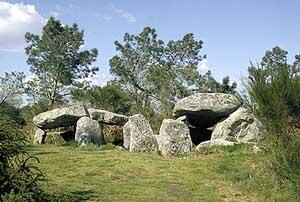- Home
- Discover the megaliths of Morbihan
- Monumentalism
- Civilisations and megaliths
- Changes in "dolmenic" tomb structure
Keriaval at Carnac is an illustration of a sophisticated dolmenic tomb with a complex funerary area.
There is a general consensus that the first Breton passage tombs were single-chamber tombs with round or polygon-shaped chambers and a relatively simple architecture.
These were soon extended. Square-shaped chambers appeared and, in the largest groups, monuments with a particular status were erected, differing from the others by the presence of a very long passage and a very high
cairn.
The need for greater diversification and specialisation of the funerary space led to the creation of new subdivided-chamber tombs.
The end of the 5th millennium BC and the beginning of the 4th marked the peak of this period.
During the 4th millennium, an opposite trend towards "de-differenciation" began, with the distinction between the chamber and the passage becoming less clear and the need for monumental architecture fading as the funerary surface increased.
At the end of this millennium, chambers began to be extended, resulting in the creation of the small specific group of "L-shaped" or "elbow" tombs on the Morbihan coast.
In other parts of Brittany, the length of the passage and the size of the monument decreased to create the 3rd millennium gallery-type tombs ("V-shaped" tombs, lateral entrance tombs, "gallery graves", reflect the influence of the Parisian basin and even of the Netherlands).
In Western Brittany, the use of megalithic tombs seems to have come to an end rather suddenly when the first Bronze Age settlers arrived in the area, around 2200 - 2000 BC, and developed the "Tumulus armoricains" culture.
Evolution of neolithic monumental funerary architecture, in western France
- a "linear" model (suggested by C. Boujot and S. Cassen):
- a "complementary" model
Although it has been levelled, the structure of this small dolmen, with its chamber and passage, is clearly visible.



